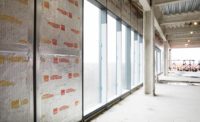Does this sound familiar to you? The drywall is ready to be installed on your project, but the insulators aren’t finished yet, so the drywall and your installers have to be sent back, delaying the project and costing more money.
The scenario is far too common.
On any construction project, timely coordination of contractors is imperative to complete a job on time and on budget. If subcontractors are holding you up, it throws a wrench into the whole operation.
Most drywallers choose not to handle the insulation portion of jobs, instead purchasing the materials themselves and contracting out the labor. If drywall companies handled the insulation in-house, they would have more control over the project as well as having more capabilities in their service portfolio.
Why would any business owner object to the prospect of profitably growing their business offerings and attracting new clients? The top two objections from drywall companies are typically: “We’re so busy already we don’t want to do insulation,” and, “We don’t want to spend the time and money learning something new.”
The belief that adding insulation services to your offerings will end up costing more time and money couldn’t be more false. In fact, many drywallers have installed insulation before and already know how to handle install. There are also no additional permits, certifications or insurance required. This is in contrast to hiring subcontractors, who will need to have their own insurance or have it provided for them by the drywallers or the general contractor.
As for the argument of being “too busy,” if you’re already bidding on a project, purchasing all the materials and hanging the drywall, installing the insulation is a minor piece to add to the puzzle.
Project Efficiency
Handling insulation in-house means more control over timelines, labor, costs and materials for increased project efficiency and accuracy. Installing the insulation can help offset downtime between phases of the job and cross-training the installers will make them more valuable to your overall employee labor pool.
True scenario: A drywall company hired an insulation subcontractor for a project that was originally bid for in-house installation. The insulators received and installed the materials from the drywall company but left the extra materials outside after the work was completed. This material was left unprotected for three days and it was destroyed by rain. If the labor was handled in-house versus subcontracted, this material dollar loss could have been avoided and put to the profit side of the P&L.
Costly errors like this one can be avoided when you manage every detail of your project from end to end. If two kinds of insulation are required, for example, you can personally ensure each is installed in the correct place. You also know exactly when the work is done and if it has passed inspection. This means you can coordinate material deliveries accurately and move forward with the next step of the job without any lag time.
Cost Savings and Gains
In addition to improving efficiency and increasing job speed, if drywallers are also in the insulation business there are service and upselling opportunities to create additional income such as sound attenuation, air sealing or dust control due to air infiltration. It also gives your business more flexibility to adapt to market fluctuations. If drywall jobs are temporarily in short supply, you can do insulation jobs to fill the lull and vice versa.
Simply put, if you are outsourcing your insulation services, you are leaving money on the table. Sometimes a lot of it.
Let’s take a closer look at the scenario from above by the numbers:
Example Job
A generalized bid example for our scenario shows a relatively healthy profit
of 15 percent.
Total Material Cost: $26,320 (includes accessories, taxes, restocking and fees)
Subcontractor Labor: $11,000
Total Job Cost: $37,320
Minus Total Bid: $43,906
Total Profit: $6,586 (15 percent)
Profit Loss on Job
When we factor in profits lost due to contracting out labor and the cost
of the destroyed materials, we see a different picture.
Self-Perform: $11,000 - $7,250 (subcontractor versus in-house labor) = $3,750
Material Loss: $1,645 + $880 = $2,525 (due to getting wet)
Total Profit Loss: $3,750 + $2,525 = $6,275
Self-Performing Profits: $6,586 + $6,275 = $12,861 (30 percent)
We see an increase of $6,275 in profit—or an additional 50 percent—if the project was handled entirely in-house. If a drywall company does 10 jobs per year, that’s an additional profit of $62,750 or more. That additional profit could also be leveraged to lower the total bid amount on the job, making your bid more attractive to potential clients. Either way, it’s a lost opportunity.
Order Properly
Another important aspect to consider from this scenario is why there were extra materials after the insulation was completed in the first place. Even if the materials were not destroyed, that is still extra money down the drain.
Improper material ordering is a common situation that creates unnecessary profit loss on jobs for drywallers. Materials are ordered in bulk from a drywall yard with no advice on how much to buy, often resulting in extra materials left over on job completion. Job gaps and errors such as this are avoidable and should be addressed whether you’re using subcontractors or not to optimize efficiency and profits. Working with a good distribution partner can help you learn how to address this issue.
Conclusion
Handling the ordering and installation of insulation on drywall projects in-house adds efficiency, control and additional job opportunities for drywallers. A small shift in your business can create a large shift in profits and the products are easy for your crew to install with very little training.









